 |
|
|
|
|
|
|
|
|
|
|
|
|
|
|
|
|
|
|
|
|
|
|
|
|
|
|
|
|
|
|
|
|
|
|
|
|
|
|
|
|
|
|
|
|
Carburetor VS Fuel Injection |
|
|
|
When you start a car, you trigger a series of actions that eventually leads to combustion and power. There are 2 kinds of systems used on an engines that make the fuel and the air mix right and burn. They are the carburetor and fuel injection system. In the following I will compare the two. |
|
|
|
Carburetor |
|
|
|
Carburetors on cars are steadily becoming a thing of the past. In the 1980's, people demanded more performance and a cutdown on emissions of monoxide and other polluting gases. They wanted their cars to be able to start without warming them up for 10 minutes. But they still are used in some airplanes and other motored vehicles. A carburetor works because of 2 principles. The Venturi principle was discovered by an Italian physicist, G.B. Venturi, and is the principle behind a jet. Another principle, the Bernoulli principle states that as the velocity (basically speed) of a gas increases, the pressure drops. In a certain midrange of throttle in a carburetor, which has a Venturi or jet, the velocity doubles and the pressure halves. When air goes into Venturi, which is the carb throat, it accelerates and the pressure drops below atmospheric pressure. If the throttle is wide open then there is the least pressure. If you put a small hole in the side of the carburetor and gasoline is put above it in a float bowl then there will be a fuel flow into the airstream in the Venturi. This happens because there is lower pressure inside the carb throat then outside so the fuel is sucked in because of the vacuum created. The more air pulled in, the less pressure in the throat, so more gasoline is pulled in. The air to fuel ratio remains constant because of this. The carburetor does not always meter the flow right. At idle the pressure drop is almost nothing in the throat so little fuel is pulled through. Another small fuel jet is placed near the throttle butterfly, which is the "door" to the venturi, and it helps the carburetor get fuel. The butterfly is what controls the air getting in. There is a high pressure on the butterfly so the jets lower pressure makes fuel flow in at idle. Conversely, when high throttle is reached, air can not be pulled in fast enough so there is a point of maximum flow. This document is just a brief overview of a carburetor so you can get the main idea. If you wnat to know about enricheners, chokes, and other carburetor info or don't quite understand then check out my Links page for other sites on carburetors. |
|
|
|
RC AIRPLANE CARBURETOR DIAGRAM |
|
|
|
This is from a .46 model engine and is a very simple construction. It will show you how a carburetor works. |
|
|
|
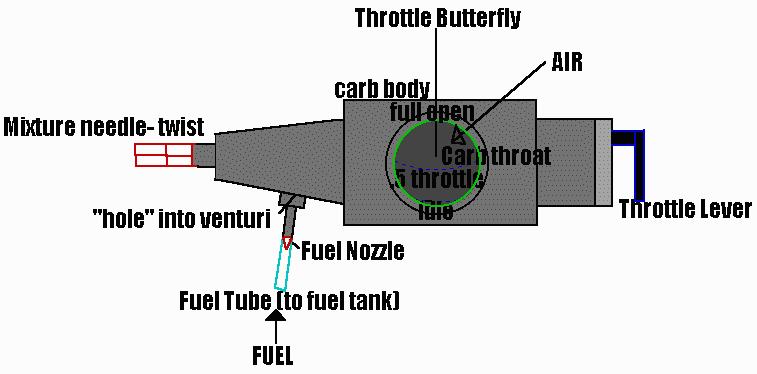 |
|
|
|
CARBURETORS |
|
|
|
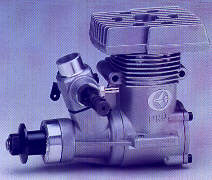 |
|
|
|
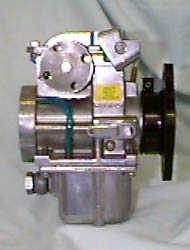 |
|
|
|
|
|
Fuel Injection |
|
|
|
Fuel Injection is the new thing for cars. It is more effective than carburetors and is now widely used. In the late 1980's, fuel injection began to dominate all US engine systems. But the fuel injection goes back longer than that so I will tell you about its history. In the mid 1950's, Bendix Cars made a electronic fuel injection system. In 1965, the Ford Indy cars appeared. They soon took over in racing and won most of the races. The problem with this fuel injection was that racing cars are at high speeds at most of the time and this didn't suit the stop and go of street cars. In Germany, Robert Bosch GmbH had made diesel fuel injection and made a Mercedes engine in 1955. (300SL) From then on the systems were refined till today's standards were reached. injection systems force fuel under pressure into the airstream. They meausure the amount of air coming into the system. Now that you know something about fuel injectors, I will take you through a sequence in a engine. A fuel injection system has 4 cycles or stages. They are intake, compression, combustion, and exhaust. First, when you start the engine it begins to fire. Then air goes into the system, the amount depending on your throttle setting. Let's say we have a high throttle setting. You would have a high pressure behind the throttle plate. The pressure, by the way is called manifold pressure. So the high pressure would make a lot of air flow into the cylinders because of the lower pressure in the cylinders. The air coming in would be tested by many controllers including the amount of air and the temperature of it. This will tell the computer how much fuel should flow through the fuel injector from the fuel tank. There are many places that a fuel injector can be mounted but are mostly past the throttle plate and before the cylinders. So the fuel is added to the air in the proper air fuel ratio which is 14.7:1. The air and gasoline mixture then goes through an intake valve and goes towards the cylinders. Just this mixture will not do anything for power. You need a spark. Wait a minute. Fuel will not combust unless it is pressurized to a high density. Thats why you have a piston. If you've ever seen a World War II submarine movie and seen some revolving things in the engine room of the diesels then you've seen pistons. A diesel is actually very similar to fuel injection. The piston revolves around and pressurizes the mixture in the cylinders. Engines usually have 2-8 cylinders and pistons. Now the spark. The spark plug ignites the fuel and combustion occurs. It ends at a point called ATDC. This is just past the top of the cycle. If combustion doesn't occur here then engine power output is reduced. But wait a minute. If the throttle is at high, it revolves 10 times as fast as idle. If the spark plug ignites at the same point on the pistons revolution at low revolutions per minute then the combustion will not end at ATDC for a high throttle vs. a low throttle. The piston travels around faster at higher throttles. That is why computers now ignite the spark plug at a earlier point in the revolution for a higher throttle so the combustion ends at ATDC still. For example, at idle the piston travels 41 degrees around a circle and starts at 342 degrees. At maximum RPM, the piston travels 63 degrees and starts at 320 degrees, 22 degrees earlier than idle. If you do the math, you can see that ATDC is at 23 degrees. The combustion ends and the wheels roll and your car starts. This process continues until you shut off your engine. You probably don't understand the pistons cycle very well because it is hard to explain in words, so I have a diagram below that shows ATDC and combustion. Also there is a diagram of the intake of air in an engine on my air- fuel ratio page. As I said in the carburetor description, if you want to know more, go to my Links page. |
|
|
PISTON |
|
|
|
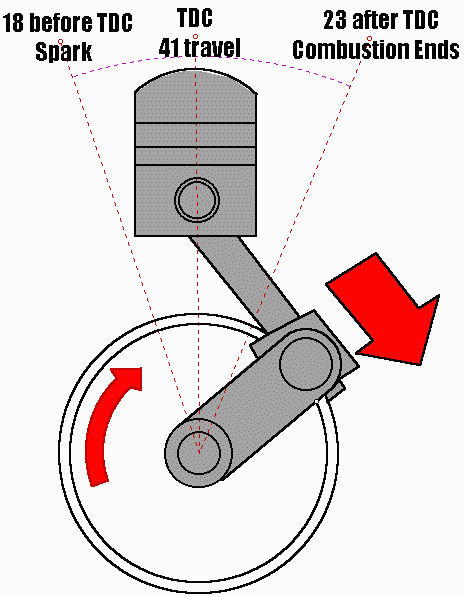 |
|
|
|
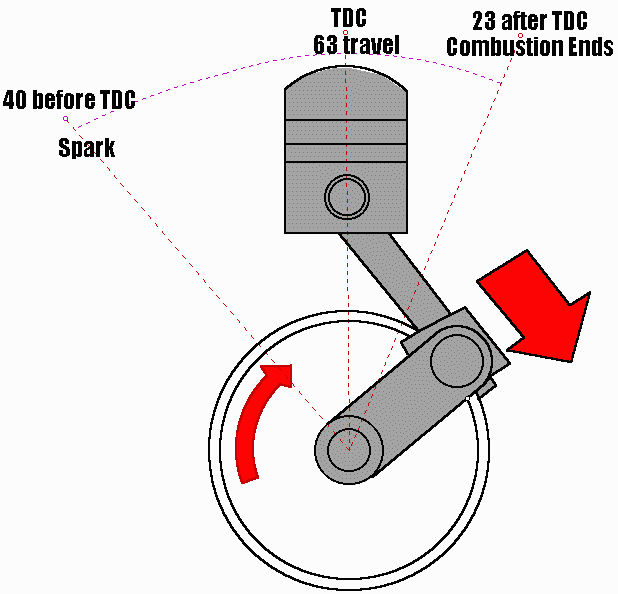 |
|
|
|
|
|
 |
|
|
|
to home page |
|
|
|
 |
|
|
 |
|
|
|
|









